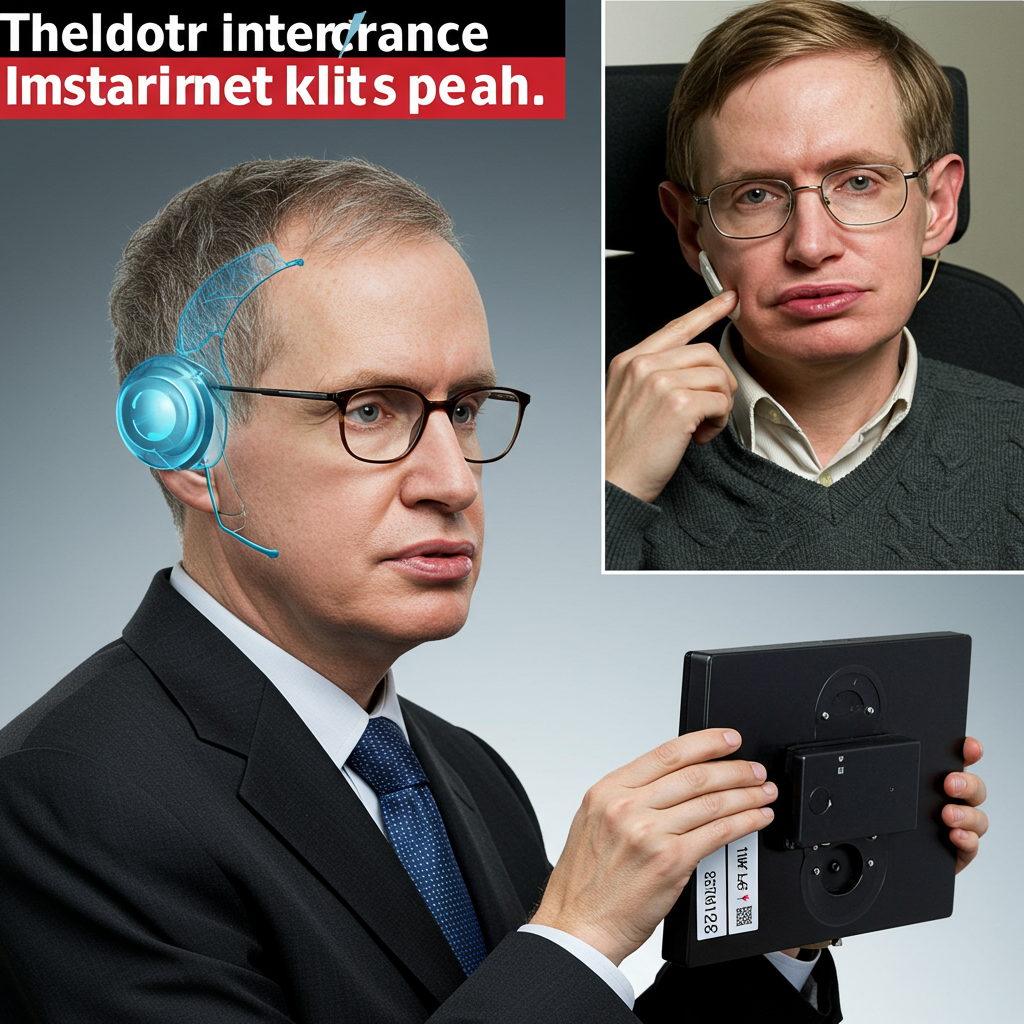Losing the ability to speak is a profound challenge, severely impacting a person’s connection to the world. For individuals living with conditions like ALS or paralysis, communication often relies on laborious methods, a reality exemplified by the late physicist Stephen Hawking. Despite his brilliant mind, Hawking communicated painstakingly, selecting characters one by one with a cheek muscle sensor, generating speech at a rate of mere words per minute. This output was then synthesized into a robotic voice lacking natural inflection.
Decades later, brain-computer interfaces (BCIs) have emerged, offering hope by translating neural activity into text or even synthesized speech. However, these systems have historically faced significant hurdles. Many were slow, suffered high error rates, were limited to small predefined vocabularies, and struggled to capture the natural nuances of human voice, such as pitch, rhythm, and intonation. Imagine trying to have a fluid conversation or express emotion when every word feels delayed and lacks inflection.
A New Era in Neural Prosthetics: Real-Time Voice
Now, a team of pioneering researchers at the University of California, Davis, has achieved a remarkable breakthrough. They have developed a neural prosthesis capable of translating brain signals directly into sounds and words in near real-time. This groundbreaking technology represents a significant leap toward creating what the researchers describe as a “fully digital vocal tract,” offering a lifeline for natural, expressive communication for those who have lost their voice.
Leading the study was neuroprosthetics researcher Maitreyee Wairagkar. Her team aimed to create a flexible system that would allow patients with paralysis to speak fluently, controlling their own cadence and expressing emotion through voice modulation. This ambitious goal required tackling nearly every major limitation encountered by previous BCI communication solutions.
Overcoming the Limits of Text
Previous successful BCI systems primarily focused on translating brain signals into text displayed on a screen. While impressive, enabling users to spell out messages neuron by neuron, this approach was inherently limited. Early brain-to-text systems demonstrated error rates around 25 percent. Later, a system developed by the UC Davis team, led by neuroscientist Sergey Stavisky, improved accuracy dramatically to 97.5 percent – meaning almost every word was correct.
However, communicating solely through text feels like text messaging compared to a phone call. It introduces delays, makes natural interjections difficult, and often leads to being interrupted in conversations. Furthermore, text-based synthesis methods added another layer of latency. These systems also relied on limited dictionaries, sometimes containing only around 1,300 words. Trying to use less common words, foreign phrases, or even simple sounds like “um” or “uh” could cause the system to fail. This dictionary constraint severely restricted spontaneous and flexible conversation.
The fundamental problem was clear: generating speech from text created bottlenecks. Wairagkar and her colleagues realized a more direct approach was needed. Their innovation focused on translating brain signals not into predefined words, but into the basic building blocks of speech: sounds (phonemes) and their accompanying features.
How the System Works: Decoding Neural Signals into Sound
The investigational BCI system was tested with a participant codenamed T15, a 46-year-old man living with severe ALS who had lost his ability to speak intelligibly years prior. Before this study, he communicated using a gyroscopic head mouse. He was already a participant in the BrainGate2 clinical trial at UC Davis Health, where he had undergone surgery to implant 256 microelectrode arrays. These arrays were placed in his ventral precentral gyrus, a brain region crucial for controlling the muscles involved in speech production.
The new brain-to-speech system leveraged these same 256 electrodes. The researchers recorded the high-resolution activity of hundreds of individual neurons as the participant attempted to speak sentences displayed on a screen. This neural data provided the intricate patterns associated with his intended speech sounds at each moment.
This torrent of neural activity was then fed into a sophisticated AI algorithm called a neural decoder. This decoder was specifically trained to interpret these complex firing patterns and extract critical speech features, including pitch and voicing. These features were then passed to a vocoder – another algorithm designed to synthesize audible speech. Crucially, this vocoder was trained using recordings of the participant’s voice from before his ALS progressed, allowing the synthesized output to resemble his own natural voice.
Near-Instantaneous Communication and Expressiveness
The result was transformative. The entire process – from the participant attempting to speak, to the recording of neural signals, decoding by AI, and synthesis of sound – occurred with astonishing speed. The latency was measured to be as low as 10 milliseconds, an average of around one-fortieth of a second. This minimal delay is comparable to the auditory feedback a person experiences when hearing their own voice as they speak, effectively enabling near-instantaneous speech synthesis.
Because the prosthesis decodes brain signals into sounds rather than relying on a word dictionary, the participant was free to attempt saying anything. This included using interjections (“um,” “hmm”), pseudo-words not found in any standard vocabulary, and even attempting to sing short melodies.
Moreover, the system proved sensitive to variations in neural activity related to prosody and intonation. The participant could modulate the pitch of the synthesized voice, using a rising intonation at the end of a sentence to ask a question, or changing pitch and emphasis on specific words to convey different meanings. This ability to control vocal nuance is vital for natural and effective human communication, adding a layer of expressiveness previously missing in BCI speech systems. The participant himself reported feeling “happy” and that the synthesized voice “felt like my real voice.”
Performance and Future Potential
To assess the system’s effectiveness, the team conducted intelligibility tests with human listeners. In a closed-set test, where listeners matched the synthesized speech to one of six possible sentences, the system achieved a perfect 100 percent intelligibility.
However, the true challenge came in an open transcription test, where listeners had to transcribe the synthesized speech without any prompts. Here, the word error rate was 43.75 percent. While this means listeners correctly identified approximately 56 percent of the words, indicating the system isn’t yet perfect for seamless daily conversation, it represents a significant improvement over the participant’s unaided speech intelligibility, which had a staggering 96.43 percent word error rate (only about 4 percent correct) in the same test.
The researchers view this as a crucial “proof of concept.” While not yet ready for open-ended conversations, it demonstrates the viability of real-time, sound-based brain-to-voice translation. The team believes performance could be dramatically improved by using BCIs with more electrodes – potentially thousands, compared to the 256 used in this study.
The path forward is promising. Startups are already developing high-density electrode systems specifically for speech neuroprostheses. Paradromics, for instance, is developing a 1,600-electrode system and is seeking FDA approval to begin clinical trials for speech restoration, with UC Davis researchers involved. The hope is to replicate these promising results with more participants, including those who have lost speech due to stroke or other neurological conditions, validating the technology’s broader potential. While market availability may still be 5-10 years away, this research represents a critical milestone in restoring natural voice to those who need it most.
Frequently Asked Questions
How does this new BCI system create speech without typing?
This revolutionary brain-computer interface system works by translating neural signals directly into sounds (phonemes) and their features like pitch, instead of converting them into text first. Electrodes implanted in the brain’s speech motor control area record neural activity as the user attempts to speak. AI algorithms then decode these signals into intended speech sounds and features, which are used by a vocoder to synthesize audible speech almost instantly, bypassing the need for a dictionary or text generation step.
Where is this brain implant research taking place?
The primary research described in this article was conducted by a team at the University of California, Davis. The study involved a participant in the BrainGate2 clinical trial, which is also conducted at UC Davis Health. Future clinical trials utilizing higher-density electrode systems for similar speech neuroprostheses are anticipated to involve UC Davis researchers and potentially other institutions working on advanced BCIs like the company Paradromics.
How effective is the synthesized speech from this implant currently?
In testing, the system allowed a participant to speak with minimal delay, control intonation, and utter novel words. In a closed-set test, human listeners achieved 100% intelligibility. In a more challenging open transcription test, listeners correctly understood about 56% of the words. While this is a significant improvement over the participant’s unaided speech (~4% understood), researchers consider it a “proof of concept” showing immense potential, but not yet ready for seamless daily conversations.
This breakthrough research offers significant hope for individuals affected by paralysis and loss of speech, paving the way for more natural, real-time communication through cutting-edge neurotechnology.




